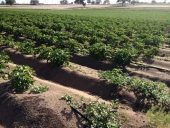
 5
5




 3
3




Standing on the shoulders of giants. Giants with dirt under their nails
 2
2




It is necessary, therefore it is possible.
(Borghese)
 9
9




 6
6




 4
4




Southwest MO, Zone 6b - Just a lady who loves to garden!
 3
3




- "TheRainHarvester" on YouTube
 4
4




- "TheRainHarvester" on YouTube
 5
5




 3
3





 3
3




Works at a residential alternative high school in the Himalayas SECMOL.org . "Back home" is Cape Cod, E Coast USA.
 3
3




If the wind doesn't blow, row.
 2
2




Sher Miller Lehman wrote:My leaf mold system: always a place to add new leaves & always a pile if completed leaf mold. Process is much faster and takes only a little effort.
I set up 3 framed screens that sit at an angle from the ground. I use a large medium and small size mesh. (1 inch, half inch, quarter inch for example).
Fresh leaves get dumped in pile next to big screen. I throw leaves on the big screen. What falls through becomes the second pile. What doesn't fall through goes back to 1st pile with new leaves.
I throw the 2nd pile on the medium screen. What falls through becomes the 3rd pile. What doesn't fall goes back to the 2nd pile.
Then I throw the 3rd pile on the smallest screen. What falls through goes into the 4th pile, the finished leaves. What doesn't fall through goes back to the 3rd pile.
The final pile is a perpetual source of finished leaf mold so I always have some ready to use. The first pile gives me a place to throw leaves as they fall.
 2
2




If the wind doesn't blow, row.
 4
4




Rebecca Norman wrote:I'll pile on with another question.
I live in high desert, very very dry. I started new gardens 3 years ago, and it's been difficult to build up soil fertility and organic matter. There is very little waste biomass, but there are some people in my village who burn their leaves, so I did manage to get several large sacks, hard packed, of leaves last fall and lass the previous fall. But they stayed bone dry, and with some difficulty I mixed them into my garden soil. The sacks are that woven plastic tarp type of stuff, will probably flake off if left out in the sun. But maybe I should pour some water down into the sacks and just leave them? Should I try to inoculate them with fungus or just water them? What do you think? I'm pretty excited about the rhapsodies for leaf mold on this thread!
Nails are sold by the pound, that makes sense.
Soluna Garden Farm -- Flower CSA -- plants, and cut flowers at our farm.
 3
3








Invasive plants are Earth's way of insisting we notice her medicines. Stephen Herrod Buhner
Everyone learns what works by learning what doesn't work. Stephen Herrod Buhner
 3
3




 4
4




 4
4




 3
3




Lila Stevens wrote: folks are still raking up their leaves into black garbage bags (sometimes thick contractor bags, yikes) and putting them out for collection. I loaded up the back of my truck again and again this past fall. My daughter got really annoyed


 4
4




- Tim's Homestead Journal - Purchase a copy of Building a Better World in Your Backyard - Purchase 6 Decks of Permaculture Cards -
- Purchase 12x Decks of Permaculture Cards - Purchase a copy of the SKIP Book - Purchase 12x copies of Building a Better World in your Backyard
 4
4




. . . bathes in wood chips . . .
 5
5




This is all just my opinion based on a flawed memory

 2
2




 3
3




Ben Zumeta wrote:If one behavior demonstrates our society’s self-destructive disconnection with decomposition cycles, it is the absurd obsessive export of leaves from landscapes where they supposedly want to grow healthy plants.
 2
2




Tomorrow's another day...
 1
1




Emilie wrote:
This year everywhere I look, the tree leaves have orange spots, or orange and brown spots, or lots of little black spots. Or growths on them. Not healthy looking at all. It's been this way since at least July, too. So I'm really hesitant to try to do anything with them.
What do you all think?
















- Tim's Homestead Journal - Purchase a copy of Building a Better World in Your Backyard - Purchase 6 Decks of Permaculture Cards -
- Purchase 12x Decks of Permaculture Cards - Purchase a copy of the SKIP Book - Purchase 12x copies of Building a Better World in your Backyard
 2
2




Timothy Norton wrote: The plan is to place those bags on a far corner of my property and just leave them there for months. Ideally, the leaves in the bags will experience all sorts of weather and just start breaking down for future use. Only some upfront work and then distribution after enough time has elapsed. I'll have to follow up with my findings.
Invasive plants are Earth's way of insisting we notice her medicines. Stephen Herrod Buhner
Everyone learns what works by learning what doesn't work. Stephen Herrod Buhner
 2
2












 2
2








Ken Peavey wrote:
HOW TO MAKE LEAF MOLD
1 pile up a bunch of leaves
2 walk away

|
Bananas grow on a stalk like grain. And in bunches like grain. This tiny ad says "grain"
The new permaculture playing cards kickstarter is now live!
https://www.kickstarter.com/projects/paulwheaton/garden-cards
|







